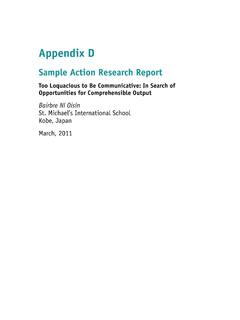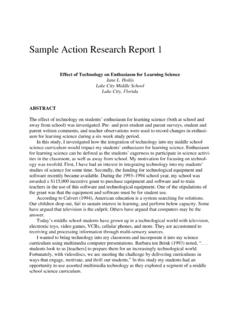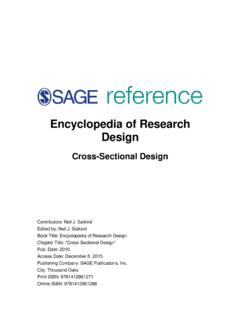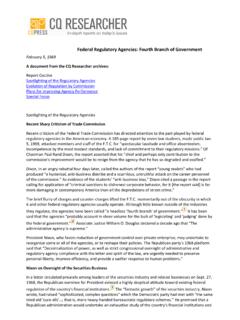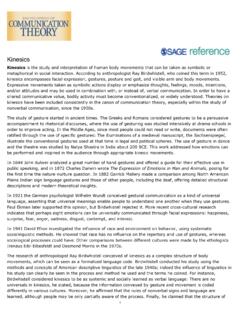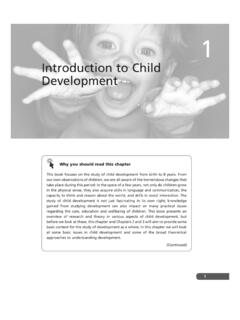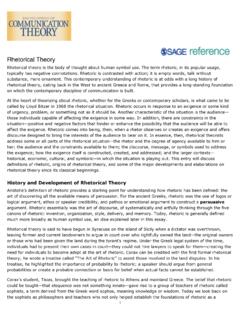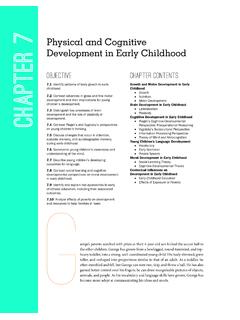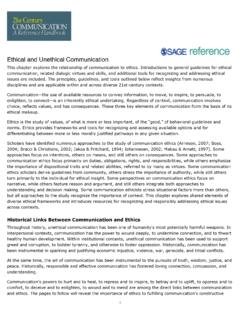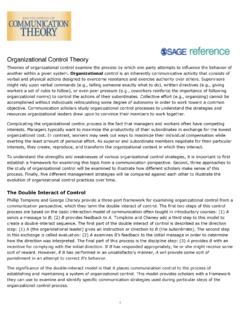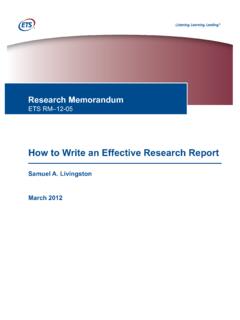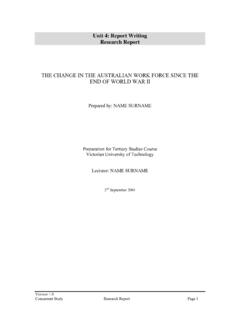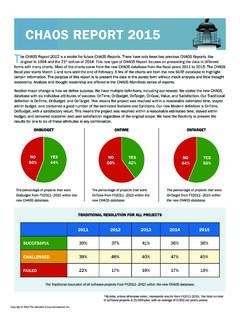Transcription of Sample Action Research Report
1 Appendix D. Sample Action Research Report Too Loquacious to Be Communicative: In Search of Opportunities for Comprehensible Output Bairbre N Ois n St. Michael's International School Kobe, Japan March, 2011. Contents Acknowledgements How effective was my Introduction Action plan? What is the background of this Action What do I want to explore after this Research ? Action Research ? Literature Review & Purpose of This Action Conclusion Research How do I feel about classroom Why is interaction important for interaction in the end? ESOL students? My Message to the EARCOS Community Method How can the results of Action Research Who participated in this Action impact us? Research ? References What did the participants do? Appendix How was the data collected? Picture cards used in the Results and Reflection pretests What was my weakness? Picture cards used in the What was my Action plan? posttests ACKNOWLEDGEMENTS. First and foremost, I would like to thank the East Asia Regional Council of Schools (EARCOS) for considering our professional growth and taking the initiative in launching the EARCOS Action Research Grant.
2 This is a splendid opportunity not only for each educator to enhance their teaching and their students' learning, but also for all educators of EARCOS. to be further unified as a learning community. I feel honored to be nominated for one of the first awardees, and I hope that many educators in the community will avail of this wonderful opportunity in the future. My special thanks are due to Mr. Bill Oldread, Assistant Director of EARCOS, whose kind and encouraging words navigated me through the process. I am grateful to Mr. Paul Grisewood, Head of School, who recognized the importance of this Action Research for me and my students. Last but by no means least, I would like to thank both my students and their parents, who allowed me to set out this meaningful journey together. I promise to make a continu- ous effort to become a better teacher. INTRODUCTION. What is the background of this Action Research ? Recently, I had the good fortune to come across an insightful and implicative book entitled Becoming an Emotionally Intelligent Teacher.
3 In the book, Powell and Kusuma-Powell (2010). acutely pointed out that it is not always the case that enhanced knowledge and skills will automatically result in improved classroom instruction and, therefore, improved student learning (p. 38). I felt a strong affinity with the statement, as the underlying reason why I. had decided to carry out this Action Research was fully expressed in it. In my capacity as ESOL (English for Speakers of Other Languages) Specialist Teacher, I. have been striving to keep abreast with different curriculums, methods, theories, Research findings, activities, textbooks, and so forth, in order to find the best method for my stu- dents. To that end, I have been reading many teacher reference books and academic arti- cles, as well as attending lectures and professional development courses. Such activities surely help me to build a larger teaching practice repertoire. However, it does not mean that I can be more confident in the validity and effectiveness of my teaching in view of each student's English language development, as my students bring diverse English language needs into my ESOL classroom stemmed from the differences in their mother tongue, cul- ture, age, length of time they learn English, and the way their English improves.
4 Ironically, the more I increase my knowledge, the more I come to realize that it is highly unlikely that a single instructional approach or method is likely to be effective for all ELLs [English Language Learners] (Genesee, Lindholm-Leary, Saunders, and Christian, 2006, p. 227). In fact, Kumaravadivelu (2003) articulates that there is no best method out there ready and waiting to be discovered (p. 1) for language teaching, and recommends us to review and improve the fundamental dimensions of our classroom, stating as follows: Creation and utilization of learning opportunities in the classroom are ultimately in the hands of teachers and learners who are engaged in a joint exploration of learning and teaching . (p. 47). I decided to scrutinize my classroom interaction with my students through this Action Research , because it is an inescapable and inescapably crucial aspect of classroom life (Allwright, 1984, p. 159) regardless of the content of my lessons, and I felt that enrich- ing this aspect of my classroom was vital for me in order to serve my students' various language needs individually, but holistically.
5 Note: Different acronyms are used to refer to non-native speakers of English who receive their education through English, such as EAL (English as an Additional Language), ESL (English as a Second Language), and ESOL, almost interchangeably with each other. I apply ESOL. throughout this paper, simply because it is used at my school. LITERATURE REVIEW & PURPOSE OF THIS Action Research . Why is interaction important for ESOL students? The importance of conversation and interaction for child language acquisition is described by Hatch (1978) as follows: Language learning evolves out of learning how to carry on con- versations (p. 404). She goes on to say, One learns how to do conversation, one learns how to interact verbally, and out of this interaction syntactic structures are developed (p. 404). In order to engage in conversation and interaction successfully in the classroom, ESOL. students need both to understand their teacher and peers, and to make themselves under- stood in English.
6 However, it is only natural that they sometimes fail to achieve it, due to their limited English proficiency. In such cases, it is important for them, with the help of their teacher, to make an effort to turn incomprehensible input and output into comprehensible input (Krashen, 1985) and comprehensible output (Swain, 1985). Long (1996) suggests that it is negotiation for meaning or asking for clarification that enables them to do so, and that their language acquisition is facilitated in the process, because it helps them to provide each other with comprehensible input, to give and gain feedback on contributions and to modify and restructure utterances so that meanings are made clear (Walsh, 2006, p. 22). In particular, the importance of ESOL students' opportunity for comprehensible output increases, if we pay attention to the reason why Swain (1985, 1988) drew it. She focused on the speaking and writing underachievement observed among Canadian students who had learnt French through an immersion program, and found out that there was a lack of opportunities for the students to talk, and to be asked to repair their speech in a manner that was grammatically accurate or sociolinguistically appropriate (Swain, 2005, p.)
7 472). Interestingly, they were on a par with their native French-speaking peers both in listen- ing and reading. If past experience is any guide, I have to agree with her point, as I have witnessed that ESOL students tend to have a problem in their speaking and writing, even after they develop other skills fairly well. As far as their speaking ability is concerned, it is not necessarily the case that fluency is always accompanied by the same level of accuracy. Although the importance of classroom interaction for language teaching has been spread and recognized under the name of communicative language teaching, it has been pointed out that many teachers actually fail to create a genuine communication rich classroom (Kumaravadivelu, 1993; Nunan, 1987). In fact, a teacher shoulders a weighty responsibility for the quality of his/her students' interaction in the classroom, as teachers have the role- given right to speak at any time and to any person; they can fill any silence or interrupt any speaker; they can speak to a student anywhere in the room and in any volume or tone of voice (Cazden, 2001, p.
8 82). It is my desire that I can be an ESOL teacher, who can create a communication rich classroom, where my ESOL students can actively ask for information, seek clarification, express an opinion, agree and/or disagree with peers and teachers (Kumaravadivelu, 1993, p. 12). To move toward the goal, I aimed to acknowledge and document present realities (Nunan, 1987, p. 142) of my classroom interaction, to identify the weakest fea- ture of it, and to improve it through this Action Research . METHOD. Who participated in this Action Research ? As I mentioned earlier, I am currently working as ESOL Specialist Teacher for an elementary school, where the language of instruction is English. The type and aim of the program for ESOL students may vary from school to school, but our ESOL program focuses solely on improving their English proficiency, so that they can have better access to the mainstream curriculum. The participants of this Action Research were my 19 ESOL students from three grades, whose ages were from 4 to 7.
9 ESOL students at the school are always grouped according to their age. Therefore, there were three groups of participants. All participants had entered the school with little or no English, and their English language needs were being catered for by pull-out ESOL lessons at the time of this Action Research . What did the participants do? As a part of my ESOL pull-out lessons, I try to incorporate various tasks for the purpose of improving my students' English proficiency. They are useful and effective to achieve the goal, as they require ESOL students to function primarily as language users' in the sense that they must employ the same kinds of communicative processes as those involved in real-world activities (Ellis, 2003, p. 3). This Action Research focused on this part of my lessons, and I audio-recorded my class- room interaction when my students and I were engaged in an information gap task. The task utilized a pair of picture cards.
10 They were very similar, except that one had five items that another did not. In each task, my students always held the picture card that had five more items, and I held another. The aim of the task was for my students to spot the five items in their picture card which my picture card did not have, by interacting with me. I used a commercially available material called Missed Out! produced by Frank Educational Aids. An example of a pair of the picture cards is depicted below. All the pairs of the picture cards utilized in this Action Research can be found in the Appendix. FIGURE 1 An example of a pair of the picture cards How was the data collected? I applied a one-group pretest-posttest design for this Action Research . The diagram in Figure 2. outlines an overview of the procedure. FIGURE 2 An overview of the procedure Pretest Audio-recording and transcribing my classroom interaction Intervention Analyzing the transcripts and Formulating an Action plan identifying a problem Posttest Audio-recording and transcribing Acting upon the Action plan my classroom interaction Pretest I started this Action Research by audio-recording my classroom for two weeks.
